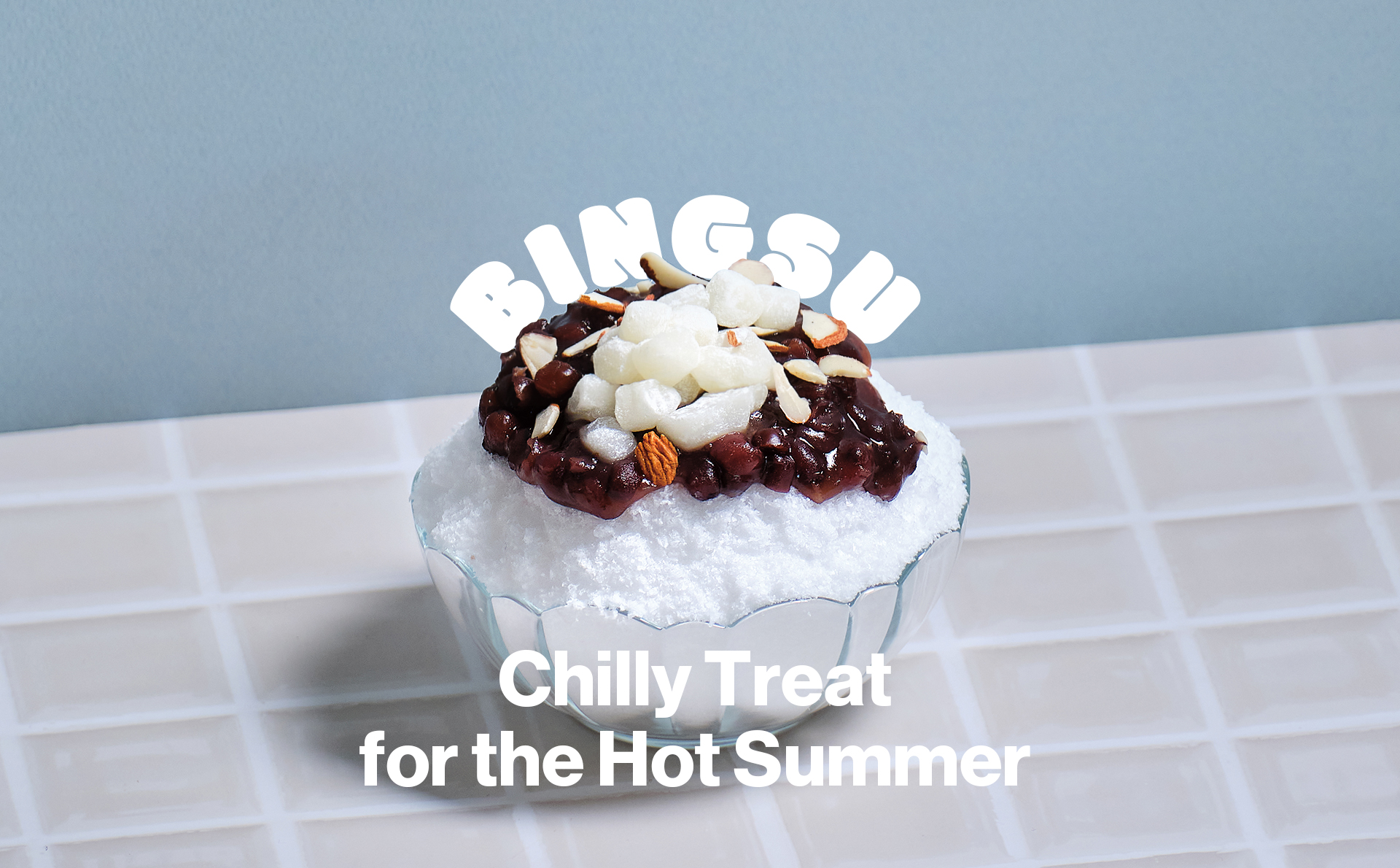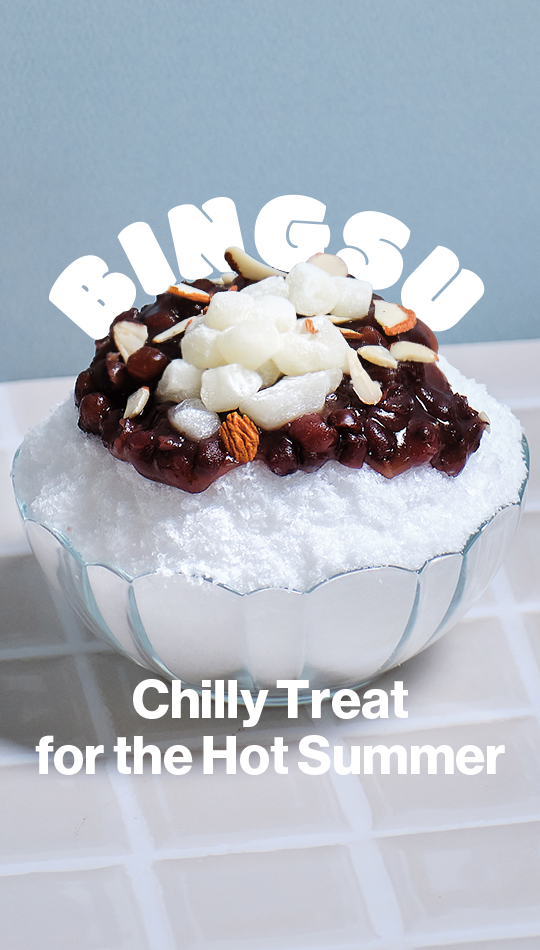After the monsoon rains in August, Korea is hit with scorching heat. Just walking outside makes people sweat profusely, which means summer has begun in earnest. That’s when people crave bingsu (shaved ice), a dessert so cold that it makes the teeth chatter. Explore the history and charm of a bowl of bingsu, a snack made from shaved ice.


Writer. Sung Ji Yeon
Beat the Heat
There are foods that represent summer in every country. This includes a variety of options such as cold foods and foods that replenish energy. There are a lot of different foods for summer in Korea, but bingsu is the one that represents summer. Bingsu is a dish that infuses tired bodies with energy thanks to its cool texture and sweet taste.
Bingsu is a dish made with shaved ice and topped with various sauces and items. It has been a representative summer snack in Korea for over 100 years. Looking at the most primitive origin of bingsu shows that it dates back to the Joseon Dynasty. The only people who could consume ice in the past were high-ranking officials, including the royal family, as places to store ice were rare. Records show that people would use their hands to break the ice into small pieces and top it with fruit.
However, the bingsu found in Korea today didn’t appear until the early 20th century. This is when bingsu took the form of a dish made with finely ground ice from an ice-making machine. The number of stores and street stands that only sold bingsu during the summer increased rapidly as ice machines became available due to the establishment of ice-making companies. There were well over 400 bingsu vendors alone in Gyeongseong (today’s Seoul) in the summer of the 1920s.
Back then, people would pour boiled pat (red beans), tteok (rice cakes) and fruit juice over shaved ice. Patbingsu (shaved ice topped with red beans) was particularly popular. Nowadays, patbingsu is one of many forms of the dish, but for decades, bingsu only meant patbingsu.
Bingsu were virtually synonymous with patbingsu until the 1980s when home bingsu machines were introduced. However, people began moving away from the use of pat in bingsu during the 1990s. The humble bowl of bingsu began to change in earnest. The dish became larger, and people started adding items like ice cream, fruits and snacks instead of pat. The number of places selling bingsu also increased rapidly. Places outside of bakeries like cafés and fast food restaurants began offering their own versions of bingsu.
The bingsu has developed remarkably since the 2000s. It used to be made from rougher pieces of ice that would crunch when people chewed it. However, recent developments have introduced a variety of ice styles. The dish can now be found with finely ground ice with a texture similar to refined sugar, ice that looks like it has been ground thinly with a plane and ice that is pulled like thin noodles. People also add milk to make the ice taste more like ice cream rather than flavorless ice made from water. Various powders such as chocolate and green tea are also added to the actual ice to add a unique taste to bingsu.
Today’s Bingsu
The bingsu is constantly evolving. Almost every aspect of the dish has changed, not just the quality and taste of the ice itself. The appearance and sales location of the dish have also changed. First, the appearance of bingsu has continued to change. It can now be found in shapes ranging from simple bingsu made in a cup to something that looks like a fruit dome. It can also look like a completely different dish such as bibimbap (a rice dish mixed with vegetables) or jjajangmyeon (noodles in black bean sauce). There are unexpected and unique forms of bingsu that make the dish look like a whole garlic bulb or plants in a field. People can enjoy a fun summer outing by going around looking for special kinds of bingsu.
The second thing is something that can’t be overlooked when discussing bingsu: the diversification of taste. Topping bingsu with mango, melon or watermelon is ordinary. Fruits and vegetables that seem rather distant from those found in sweet desserts can now be found in bingsu such as corn, tomatoes, carrots and avocados. Places also top bingsu with coffee, popcorn, cakes and cotton candy. Many people look forward to seeing what new topping will be used for bingsu each summer.
Being able to eat bingsu anywhere has been a remarkable change. The bingsu has become easily accessible through convenience stores and even as a dessert served in hotels. The bingsu served at hotels tends to be more expensive than regular bingsu, but it is so tasty and beautiful that it has exploded in popularity as a small luxury for summer. People can also find franchise cafés along every alley that have been waiting to offer their take on bingsu during summer. Is there more? Sales of bingsu have expanded into general snack bars and buffets instead of just cafes.
Bingsu constantly reflects the times and satisfies the increasingly demanding and diversified needs of consumers. The evolution of bingsu has shown that it will continue to be the representative dish of summer for Koreans as long as summer itself exists.
Melon Bingsu
10 mins.
INGREDIENTS
500 ml milk, 4 tablespoons condensed milk 1/2 melon, 1 scoop of vanilla ice cream, herbs for garnish (optional)
- Mix the milk and condensed milk. Put the mixture in a zipper bag. Flatten it out and place it in the freezer.
- Cut the frozen milk mixture into pieces and grind it with a blender or pound it with a rolling pin. Keep the mixture in the freezer.
- Remove the seeds of melon. Use a measuring spoon to scoop the pulp out in balls.
- Use the melon rind as a bowl. Place the frozen milk mixture inside the melon rind and stack the melon balls on top. Top the melon balls with ice cream. If desired, add toppings such as herbs or cookies.
Peach Cup Bingsu
10 mins.
INGREDIENTS
500 ml milk, 4 tablespoons condensed milk, 3 tablespoons cereal, 1 can of peaches, 4 tablespoons peach jam, tteok or snacks (optional)
- Mix the milk and condensed milk. Put the mixture in a zipper bag. Flatten it out and place it in the freezer.
- Cut the frozen milk mixture into pieces and grind it with a blender or pound it with a rolling pin. Keep the mixture in the freezer.
- Slice or dice the peaches. Either line the sides of the bowl with the thinly sliced peaches or fill the bottom of the bowl with the diced peaches.
- Top with cereal, frozen milk, peach jam and peach pulp, in that order. If desired, add toppings such as tteok or cookies.
